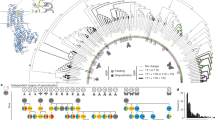Abstract
In most metazoans, the glutathione S-transferases (GST) are encoded by gene families, and are used to detoxify xenobiotics. We describe the structure of genomic loci coding for the GSTs in the housefly that have been implicated, by both genetic and biochemical means, in mediating insecticide resistance. In earlier work, we showed that one of the theta-class enzymes, MdGST-3, is overproduced in resistant flies and degrades certain insecticides. We used a fragment from a cDNA clone of MdGST-3 as a probe to screen a housefly genomic DNA bank in phage λ. This probe detected multiple gst loci. Genes for GSTs were found in five different, nonoverlapping λ clones, three of which carry multiple, closely linked gsts. Multiple genes for both MdGST-3 and MdGST-4 were found; some of which have introns in their 5′ untranslated regions. In adults, the only MdGST-3 enzymes that are expressed are encoded by the intron-free genes. A new theta-class GST (called MdGST-5) was also discovered. Fusion genes comprising 5′ MdGST-3 sequences and either MdGST-4 or MdGST-5 sequences in their 3′ halves were encountered at three separate loci. The genes described here are found in both the ancestral sensitive strain and the insecticide-resistant strains.
Similar content being viewed by others
Author information
Authors and Affiliations
Additional information
Received: 28 June 1996 / Accepted: 23 April 1997
Rights and permissions
About this article
Cite this article
Zhou, ZH., Syvanen, M. A complex glutathione transferase gene family in the housefly Musca domestica . Mol Gen Genet 256, 187–194 (1997). https://doi.org/10.1007/s004380050560
Issue Date:
DOI: https://doi.org/10.1007/s004380050560




